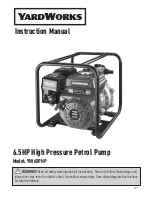
8
Instruction Manual
SECTION 2 - INSTALLATION
2.6.4 Discharge Piping Considerations
1. Install pipe large enough to prevent excessive
pressure losses on the discharge stroke of the
pump. Maximum pressure at the discharge
fitting on the liquid end must be kept at or below
the rated pressure (Max. allowable working
pressure shown on the pump nameplate).
2. The pump will not deliver a controlled flow unless
the discharge line pressure is 35 psi greater than
the suction line pressure. There are a number of
ways to create an artificial pressure, such as by
installing a back pressure valve. (Please contact
Milton Roy for recommendations to increase
back pressure in slurry applications.)
3. When pumping water-treatment chemicals
directly into boiler drums, use one liquid
end assembly for each boiler drum.
Discharging into a manifold having the slightest
pressure difference between its several
discharge connections can diminish metering
accuracy as the outlet with the lowest pressure
will receive more liquid than the outer outlets.
2.6.5 Back Pressure Valves
A Milton Roy Back Pressure Valve should be
installed in the discharge line near the pump to
ensure sufficient discharge head pressure for
proper pump metering action. Normally, the valve
should be located near the pump. However, back
pressure valves for large pumps with long and
extremely small discharge lines may have to
be installed near the point of discharge into the
process (to minimize siphoning tendencies).
2.6.6 Pulsation Dampeners
An accumulator, surge chamber, surge suppressor,
or pulsation dampener should be used with the
back pressure valve in the discharge line to
absorb the flow peaks between the pump and
the back pressure valve. Without the pulsation
dampener the valve mechanism will snap open
and closed with the surge from each pump stroke.
The pulsation dampener will allow the back
pressure valve to oscillate about a partly-closed
position, thus minimizing wear on the valve.
Discharge line pulsation dampeners offer the
further advantage of limiting the flow and pressure
variations characteristic of this kind of pump.
Installing a properly sized pulsation dampener
will improve pump performance and may reduce
system costs dramatically by permitting the
substitution of smaller piping. Please contact
Milton Roy for further information on pulsation
dampeners.













































